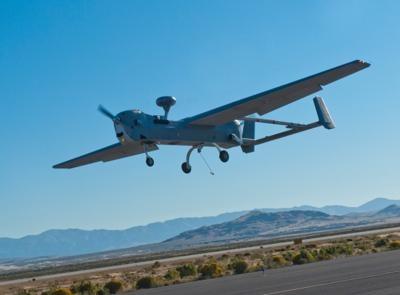Wed, Jan 15, 2014
U.S. Army Has Flown The Aircraft Since 1996
Northrop Grumman Corporation's Hunter Unmanned Aircraft System (UAS), in use with the U.S. Army since 1996, recently surpassed 100,000 combat flight hours in service. The MQ-5B Hunter, which is currently deployed supporting contingency operations across the globe, provides warfighters with state-of-the-art reconnaissance, surveillance, target acquisition (RSTA), communications relay and weapons delivery.

"Our very close working relationship with our Army customer has been critical to the program's enduring success," said Steve Hogan , vice president and general manager, Integrated Logistics and Modernization division, Northrop Grumman Technical Services. "The team's innovative partnering approach has been seamless over the years. The team has established an impeccable track record of continuous modernization and highly reliable performance while serving on the front lines shoulder-to-shoulder with our nation's warfighters in combat operations."
The RQ-5A Hunter was the Army's first fielded UAS. The MQ-5B is the next-generation Hunter, continuing a legacy of service to Army corps, division and brigade warfighters. Flying over the battlefield with its multimission optronic payload, the MQ-5B gathers RSTA information in real time and relays it via video link to commanders and soldiers on the ground.
The MQ-5B Hunter is distinguished by its heavy fuel engines, its "wet" (fuel-carrying) extended center wing with weapons-capable hard points and a modern avionics suite. The MQ-5B Hunter system uses the Army's One System ground control station and remote video terminal. It also carries a communications relay package to extend the radio range of warfighters. Hunter is also equipped with a differential GPS automatic takeoff and landing system. "This significant milestone is a credit to the sustained exceptional high levels of performance and technical expertise, dedication, professionalism and pride of all of our Northrop Grumman engineers, maintainers and operators," said Rob Sova , Hunter program manager, Northrop Grumman Technical Services. "This team lives and breathes our customer's mission and strives to exceed customer expectations every single day."
The MQ-5B features a robust, fixed-wing, twin tail-boom design with redundant control systems powered by two heavy fuel engines – one engine to "push" and another to "pull" the aircraft. Another Hunter capability is its relay mode that allows one Hunter to be controlled by another UAV at extended ranges or over terrain obstacles typical of those found in the Balkans and Afghanistan.
(Image provided by Northrop Grumman)
More News
Also: Netherlands Donates 18 F16s, 2 737s Collide On Ramp, E-7 Wedgetail Cut, AgEagle's 100th In S Korea The Pilot and Aircraft Privacy Act was introduced in the House by Represent>[...]
Pilot Also Reported That Due To A Fuel Leak, The Auxiliary Fuel Tanks Were Not Used On June 4, 2025, at 13:41 eastern daylight time, a Piper PA-23, N2109P, was substantially damage>[...]
Have A Story That NEEDS To Be Featured On Aero-News? Here’s How To Submit A Story To Our Team Some of the greatest new stories ANN has ever covered have been submitted by our>[...]
From 2023 (YouTube Edition): Reflections on War’s Collective Lessons and Cyclical Nature The exigencies of war ought be colorblind. Inane social-constructs the likes of racis>[...]
What Goes Around, May Yet Come Back Around, Klyde FMI: www.klydemorris.com>[...]
 Airborne 06.30.25: US v ADS-B Misuse, Natl STOL Fire, Volocopter Resumes
Airborne 06.30.25: US v ADS-B Misuse, Natl STOL Fire, Volocopter Resumes NTSB Prelim: Piper PA-23
NTSB Prelim: Piper PA-23 ANN FAQ: Submit a News Story!
ANN FAQ: Submit a News Story! Classic Aero-TV: One Mans Vietnam
Classic Aero-TV: One Mans Vietnam Klyde Morris (06.30.25)
Klyde Morris (06.30.25)



